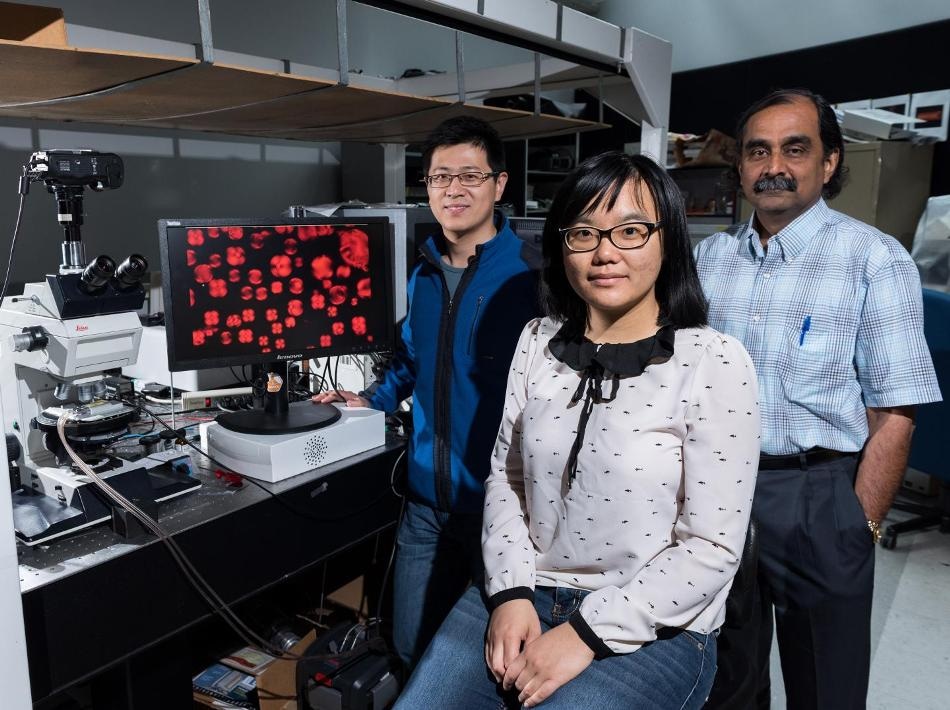Mar 27 2017
 Georgia Tech students Jinxin Fu and Rui Chang with Mohan Srinivasarao, a professor in the Georgia Tech School of Materials Science and Engineering. (CREDIT - Rob Felt)
Georgia Tech students Jinxin Fu and Rui Chang with Mohan Srinivasarao, a professor in the Georgia Tech School of Materials Science and Engineering. (CREDIT - Rob Felt)
According to a team of researchers at Georgia Institute of Technology a material, which was used for years to color food items ranging from ice creams to corn chips, could potentially have more uses in addition to being used as food dyes.
In a study published on March 23 in the Proceedings of the National Academy of Sciences journal, the team illustrated how a group of water soluble liquid crystals, known as lyotropic chromonic liquid crystals, displayed unanticipated characteristics that could be harnessed for use in sensors and other probable applications.
We were seeking to understand the aggregation and phase behavior of these plank-like molecules as a function of temperature and concentration. When observed under crossed polarizers in an optical microscope, liquid crystals can exhibit beautiful textures that hint toward how the molecules themselves are arranged.
Karthik Nayani, Former Student, Georgia Institute of Technology
To answer some basic questions relating to the phase behavior of the material, the researchers used the microscopes to study the molecules’ textures when they were confined to droplets called as tactoids.
"Surprisingly, we found a configuration that hasn’t been seen before in the 70 years that people have been studying liquid crystals," said Mohan Srinivasarao, a professor in the Georgia Tech School of Materials Science and Engineering. "Historically, liquid crystals in tactoids conform to what is known as a bipolar and a bipolar configuration with a twist. At lower concentrations, we found that these liquid crystals arrange in a concentric fashion, but one that appears to be free of a singular defect."
A simple model of the aggregation behavior of these molecules was used by the researchers to clarify these unexpected results. Additionally, spectroscopic experiments using polarized Raman microscopy were conducted to verify their findings.
These new findings enhance the growing understanding of how chromonic liquid crystals could be used in sensing applications, Srinivasarao said. The crystals are water soluble and react radically to being confined to specific patterns – such as tactoidal droplets – concentrations, and temperatures. The responsiveness of the material to modifying its environment could potentially be used to sense the chirality – or "handedness" – of molecules, Srinivasarao said.
These materials don’t have a chiral center but they exhibit a chiral structure. That in itself is very interesting.
Mohan Srinivasarao, Professor, Georgia Institute of Technology
That finding could be helpful in addressing those kinds of questions, he said.
"There are lots of people studying why on planet Earth all amino acids have a handedness, one and not the other," Srinivasarao said. "Where does this handedness come from?"
This material is based upon research supported by the Renewable Bioproducts Institute at Georgia Tech.
CITATION: Karthik Nayani, Jinxin Fu, Rui Chang, Jung Ok Park, and Mohan Srinivasarao, “Using chiral tactoids as optical probes to study the aggregation behavior of chromonics,” (Proceedings of the National Academy of Sciences, March 2017)